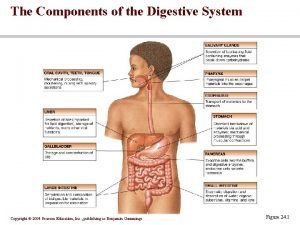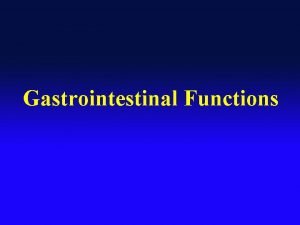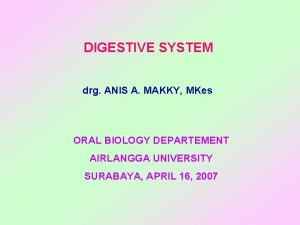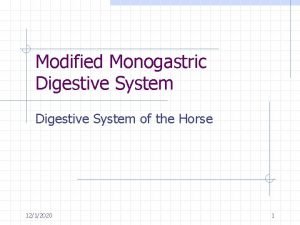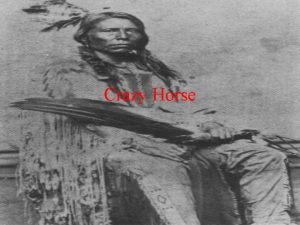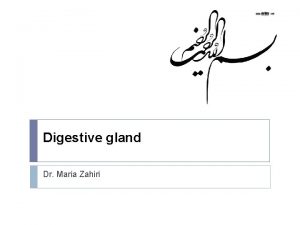Horse Science Digestive Physiology of the Horse The















- Slides: 15

Horse Science Digestive Physiology of the Horse

The Digestive Tract Horses are non-ruminant herbivores Horses are able to utilize large amounts of roughage due to their relatively large cecum Cecum is a section of the colon where digestive bacteria break down roughage

Digestive Tract The Mouth- first part of digestive system. Mouth has 2 main functions- masticate food and wet food with saliva.

Digestive tract cont. Teeth should be examined by professional periodically to check for sharp edges that must be floated or filed down

Digestive tract cont. The esophagus- 50 - 60 inches long in an adult horse. Esophagus will not allow vomiting. Stomach may actually rupture before animal will vomit.

Digestive tract cont. The Stomach- relatively small. Therefore horses should be fed several small meals per day. The Small Intestine- contains 30% of the capacity of the entire tract. Food in the small intestine is 93 -95% liquid. Nutrients are absorbed here.

Digestive tract cont. The large intestine- 25 feet long, divided into cecum, colon and rectum


Rate of passage 95% of all food eaten will be excreted in the form of feces within 65 -75 hours of ingestion

Site of Digestion Protein, Carbohydrates, fat, minerals and vitamins are all digested in the small intestine Water is absorbed in the large intestine

Factors Affecting Digestion Processing of feedspellets require less digestion than whole grains.

Feed processing Grinding feed speeds digestion

Feed Processing Crimping oats will increase rate of digestion.

Factors affecting Digestion cont. Level of intake- the more grain eaten, the less digested Frequency of feeding- frequent feeding can increase level of digestion.

Factors cont. Work- light work increases digestion, heavy work inhibits it.
 Intestine histology
Intestine histology Protein absorption
Protein absorption Parasimpathetic
Parasimpathetic Horse monogastric digestive system
Horse monogastric digestive system My favourite subject is science
My favourite subject is science Anatomy science olympiad
Anatomy science olympiad Science olympiad forensics cheat sheet
Science olympiad forensics cheat sheet Hình ảnh bộ gõ cơ thể búng tay
Hình ảnh bộ gõ cơ thể búng tay Slidetodoc
Slidetodoc Bổ thể
Bổ thể Tỉ lệ cơ thể trẻ em
Tỉ lệ cơ thể trẻ em Voi kéo gỗ như thế nào
Voi kéo gỗ như thế nào Tư thế worms-breton
Tư thế worms-breton Bài hát chúa yêu trần thế alleluia
Bài hát chúa yêu trần thế alleluia Môn thể thao bắt đầu bằng từ chạy
Môn thể thao bắt đầu bằng từ chạy Thế nào là hệ số cao nhất
Thế nào là hệ số cao nhất
